Votre message a été envoyé.
Nous traiterons votre demande et vous contacterons dès que possible.
Le formulaire a été soumis avec succès.
Vous trouverez de plus amples informations dans votre boîte aux lettres.
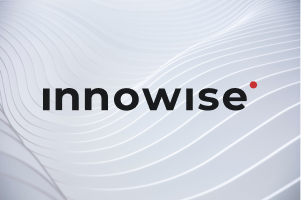
Sélection de la langue
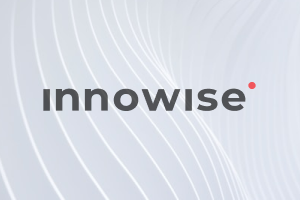

Avez-vous déjà été confronté à des projets logiciels qui dépassent constamment le budget, ne respectent pas les délais ou ne répondent pas aux attentes des utilisateurs ? Peut-être que votre équipe a eu du mal à définir ces exigences, que les responsabilités ont été dispersées, que la communication a été défaillante et que les progrès ont été bloqués. Vous n'êtes pas seul : ces problèmes sont extrêmement fréquents, mais il existe un moyen éprouvé de les résoudre.
C'est exactement ce que la SDLC (cycle de développement des logiciels) est conçu pour résoudre les problèmes. Il offre une approche structurée et reproductible de la planification, de la construction et de la fourniture de logiciels qui fonctionnent réellement.
Dans cet article, j'expliquerai ce que le SDLC signifie réellement aujourd'hui, comment il vous aide à clarifier votre processus dès le premier jour et comment il peut vous aider à fournir des logiciels plus rapidement et avec beaucoup moins de surprises.
Le cycle de vie du développement logiciel (SDLC) est un parcours structuré pour vos projets logiciels, qui décompose les processus complexes en étapes gérables - du concept initial jusqu'au déploiement et au soutien continu. Chaque phase définit des tâches spécifiques, attribue des rôles clairs et fixe des résultats tangibles, de sorte que toutes les personnes impliquées restent sur la même longueur d'onde et connaissent leur travail.
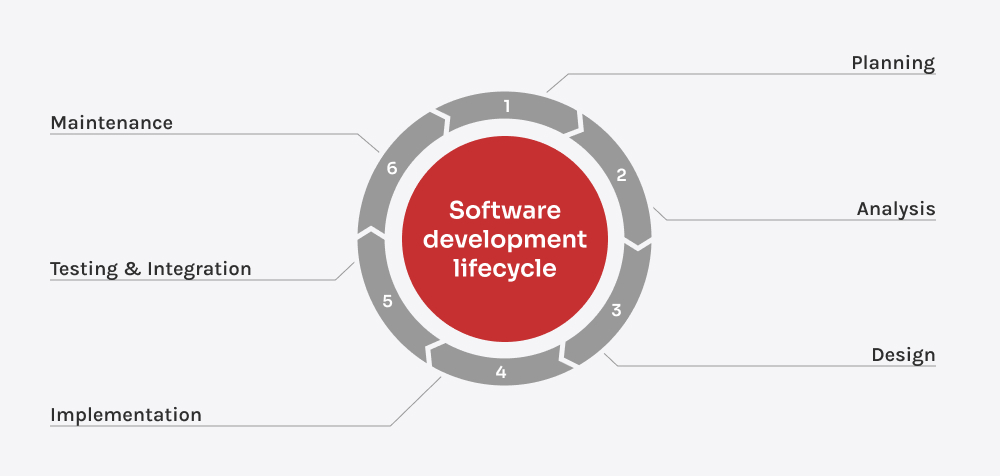
Les logiciels ne naissent pas en ligne droite. Il évolue à travers une série de phases intentionnellesdu SDLC. Le SDLC guide ce voyage, en aidant les équipes à rester alignées, à réduire les risques et à façonner des produits qui répondent réellement aux besoins des utilisateurs et des entreprises.
C'est la phase du "pourquoi faisons-nous cela". C'est là que les équipes définissent la finalité du projet, sa portée, ses objectifs, son budget et ses délais de livraison. Les analystes commerciaux et les chefs de projet travaillent en étroite collaboration avec les parties prenantes afin d'identifier les points problématiques et de définir une stratégie de haut niveau. Ce qui est fait ici : entretiens avec les parties prenantes, études de faisabilité, évaluations des risques et planification des ressources.
Une fois le projet approuvé, l'équipe commence à définir ce que le logiciel doit réellement faire. La première étape consiste à recueillir des informations auprès de toutes les parties prenantes afin de comprendre les besoins de l'entreprise et les attentes des utilisateurs. Cela conduit à la documentation des exigences fonctionnelles (ce que les utilisateurs doivent pouvoir faire) et des exigences techniques (comment le système doit se comporter sous le capot). Lors de la dernière étape, l'équipe examine et affine les exigences avant d'aller de l'avant.
Dans la phase de conception, l'équipe transforme les exigences brutes en un plan pratique pour la construction du logiciel. Elle commence par une conception de haut niveau, qui décrit l'architecture du système, les principaux modules, le flux de données et la manière dont les différentes parties interagiront. Ensuite, ils passent à la conception de bas niveau, en détaillant la logique, la structure et le comportement de chaque composant, y compris la disposition des bases de données et les algorithmes clés. Les concepteurs créent souvent des wireframes ou des prototypes cliquables pour explorer le parcours de l'utilisateur et détecter rapidement les problèmes d'utilisabilité. Cette étape permet aux développeurs de ne pas se perdre en conjectures et d'éviter des remaniements coûteux en mettant en évidence les défis techniques avant que le code ne soit écrit.
Dans la phase de développement, le logiciel commence à prendre forme au fur et à mesure que les développeurs traduisent les conceptions en code opérationnel. Ils construisent l'application pièce par pièce, souvent dans le cadre de cycles courts et ciblés qui permettent des tests, des retours d'information et des ajustements fréquents. Les développeurs ne se contentent pas d'écrire du code : ils font des choix architecturaux délibérés et structurent les fonctionnalités en vue d'une maintenabilité à long terme. Tout au long du processus, les développeurs restent en étroite synchronisation, revoient le travail des autres, affinent la logique et résolvent les problèmes en collaboration pour que le produit reste en phase avec la vision technique et les objectifs de l'entreprise.
Quelle que soit la qualité du code, un logiciel non testé est une bombe à retardement. La phase de test est l'étape au cours de laquelle le produit est testé avant d'être mis à la disposition des utilisateurs. Elle commence généralement par les tests du système, qui consistent à vérifier que l'application fonctionne comme une unité. Viennent ensuite les tests manuels, au cours desquels les ingénieurs chargés de l'assurance qualité simulent l'utilisation réelle et les cas limites. Enfin, les tests automatisés interviennent pour couvrir les tâches répétitives à grande échelle, en garantissant la stabilité après chaque nouveau déploiement.
Le déploiement est le moment où le logiciel quitte le laboratoire pour entrer dans le monde réel. L'équipe déploie le produit auprès des utilisateurs - que ce soit en une seule fois ou par étapes - tout en surveillant de près son comportement dans l'environnement réel. Cette phase implique la configuration de l'infrastructure, la mise en place de pipelines de déploiement automatisés et la préparation de stratégies de retour en arrière au cas où quelque chose tournerait mal. Les développeurs, les ingénieurs DevOps et les responsables de l'assurance qualité travaillent souvent côte à côte pour faciliter le processus de lancement, résoudre les problèmes de dernière minute et s'assurer que tout fonctionne exactement comme prévu dès le premier jour.
Une fois que le logiciel est opérationnel, le véritable test commence. L'équipe surveille les performances, répond aux commentaires des utilisateurs et s'attaque aux bogues ou aux vulnérabilités qui apparaissent dans des conditions réelles. Tout aussi important, les équipes d'assistance travaillent en première ligne, recueillant les avis des utilisateurs, tandis que les développeurs s'occupent des ajustements techniques et des améliorations à long terme. Le logiciel devient un produit vivant, constamment affiné pour rester pertinent et fiable.
La manière dont vous créez des logiciels est tout aussi importante que ce que vous développez. Les modèles SDLC structurent le chaos en aidant les équipes à gérer les objectifs changeants, les délais serrés et la lutte constante entre la qualité et la rapidité.
Le modèle Waterfall est une approche linéaire et séquentielle. Il se compose de phases distinctes : Exigences, Conception, Mise en œuvre, Test, Déploiement et Maintenance. Chaque phase doit être achevée avant de passer à la suivante. Il n'y a pas de retour en arrière possible une fois qu'une phase est terminée. Ce modèle fonctionne bien lorsque les exigences sont bien définies et qu'il est peu probable qu'elles changent.
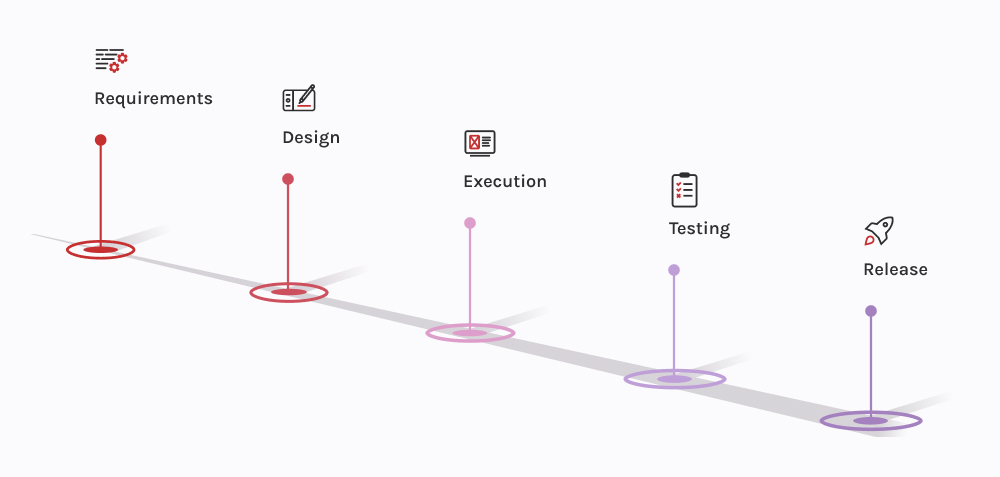
Le modèle Agile divise le projet en petites parties gérables appelées sprints, qui durent généralement de 2 à 4 semaines. Au cours de chaque sprint, les équipes développent, testent et recueillent des informations en retour afin d'apporter des améliorations. Le modèle Agile met l'accent sur la collaboration avec le client et sur la flexibilité, ce qui permet d'apporter des changements même à un stade avancé du développement. Les cadres agiles les plus répandus sont Scrum et Kanban. Elle est idéale pour les projets dont les exigences changent fréquemment, comme les logiciels qui font l'objet de mises à jour régulières.
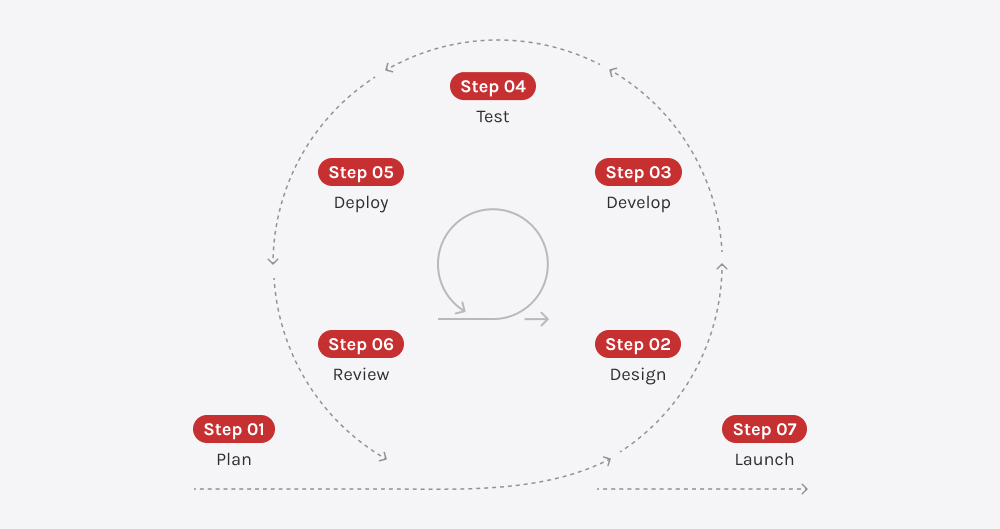
Le modèle itératif permet de construire un logiciel étape par étape. Vous commencez par une version simple du produit, puis vous continuez à l'améliorer au cours de plusieurs cycles. À chaque itération, l'équipe planifie, conçoit, code et teste de nouvelles fonctionnalités ou améliorations. C'est un choix judicieux lorsque la portée du projet n'est pas entièrement définie dès le départ, car vous pouvez vous adapter et vous améliorer au fur et à mesure.

Le modèle en spirale associe un développement itératif à une évaluation systématique des risques. Il se compose de quatre phases principales : Planification, analyse des risques, ingénierie et évaluation. Chaque boucle de la spirale porte sur un ensemble d'exigences, avec une évaluation des risques à chaque étape. Le modèle répète le processus en ajoutant progressivement de nouvelles fonctionnalités. Il est utilisé pour les projets de grande envergure, complexes ou à haut risque, comme l'aérospatiale ou les systèmes logiciels critiques.
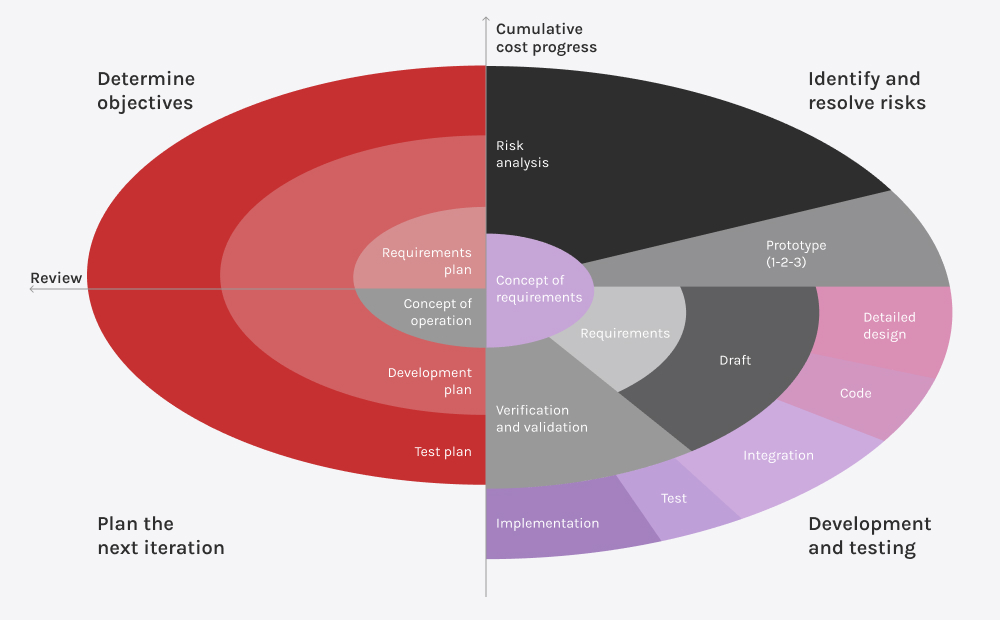
Ce modèle est similaire à celui de la chute d'eau, mais il intègre des tests approfondis à chaque étape. Après avoir terminé une phase de développement, une phase de test correspondante suit. Ce modèle est donc plus fiable pour les projets où la précision et la validation sont cruciales.
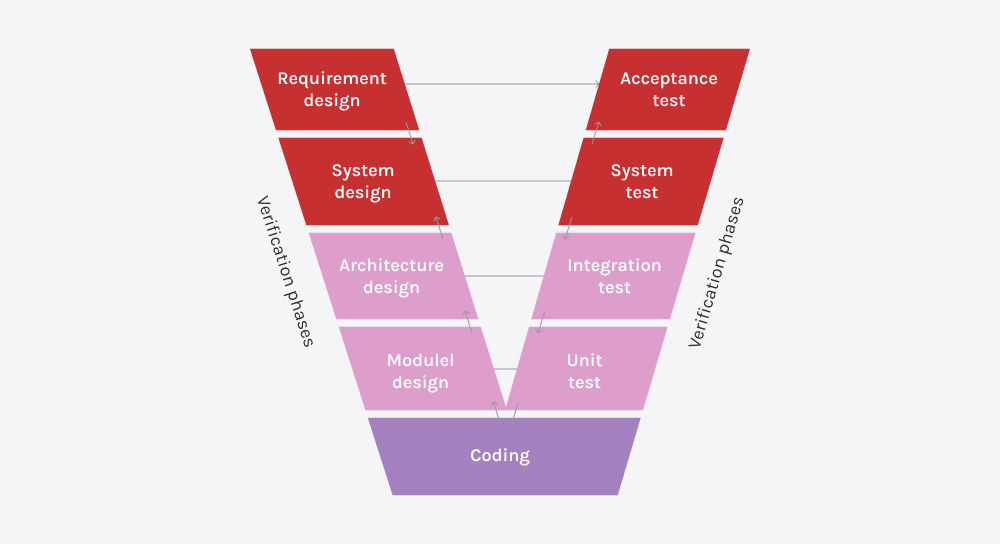
Le modèle Big Bang consiste à démarrer le développement sans grande planification. Les développeurs créent le logiciel sur la base d'exigences limitées, en visant souvent un prototype rapide. Ce modèle est très risqué et peut aboutir à des résultats imprévisibles, mais il convient aux petits projets aux exigences simples ou aux logiciels expérimentaux.
Le site DevOps est une approche qui combine le développement de logiciels (Dev) et les opérations informatiques (Ops) afin d'améliorer la collaboration, la rapidité et l'efficacité. Il se concentre sur l'automatisation des tâches répétitives telles que les tests, l'intégration, le déploiement et la surveillance.

Le choix du bonmodèle SDLCpeut donner le ton à l'ensemble de votre projet. Il ne s'agit pas d'un modèle unique - la meilleure solution dépend d'éléments tels que la taille du projet, sa complexité, le budget, les délais, l'expérience de l'équipe et le degré d'implication des parties prenantes.
Voyons comment vous pouvez associer différentes méthodologies SDLC aux caractéristiques typiques d'un projet :
| Facteur | Modèles SDLC recommandés |
| Des exigences claires | Cascade, modèle en V |
| Évolution des besoins | Agile, itératif |
| Petits projets | Cascade |
| Projets de grande envergure ou complexes | Agile, Spiral, DevOps |
| Interaction fréquente avec les clients | Agile, Scrum |
| Interaction minimale avec le client | Cascade, modèle en V |
| Budget et calendrier fixes | Cascade, modèle en V |
| Budget et calendrier flexibles | Agile, en spirale |
| Besoin de déverrouillages rapides | Agile |
| Un délai de développement plus long | Cascade, modèle en V |
| Maintenance continue | Agile, DevOps |
L'adoption d'une approche fondée sur le cycle de vie du développement logiciel (SDLC) peut réellement changer la fluidité de vos projets logiciels. Voici comment le SDLC permet de rendre l'ensemble du processus plus facile à gérer et plus efficace :
Chez Innowise, nous avons pu constater de visu comment le logiciel cycle de développement (SDLC) facilite la vie de nos équipes et de nos clients. En suivant les meilleures pratiques du SDLC, nous restons sur la même longueur d'onde avec toutes les personnes impliquées, en définissant clairement les objectifs et les attentes dès le début. Cela signifie moins de surprises, des processus plus fluides et des résultats prévisibles à chaque étape, de la planification et du développement aux tests et au déploiement.
Vous envisagez d'améliorer votre propre approche ? Consultez notre page des services et voyez comment nous pouvons vous aider à apporter clarté et efficacité à votre prochain projet logiciel.
Dmitry dirige la stratégie technologique derrière les solutions personnalisées qui fonctionnent réellement pour les clients - aujourd'hui et au fur et à mesure de leur croissance. Il fait le lien entre la vision d'ensemble et l'exécution pratique, s'assurant que chaque construction est intelligente, évolutive et alignée sur l'entreprise.
Notez cet article :
4.8/5 (45 commentaires)







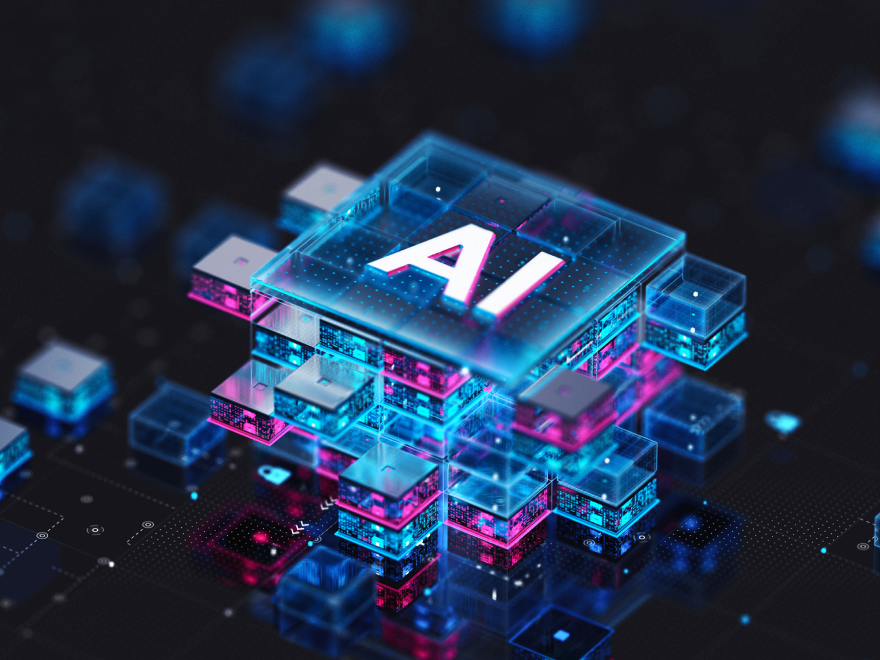




Votre message a été envoyé.
Nous traiterons votre demande et vous contacterons dès que possible.

En vous inscrivant, vous acceptez notre Politique de confidentialitéy compris l'utilisation de cookies et le transfert de vos informations personnelles.